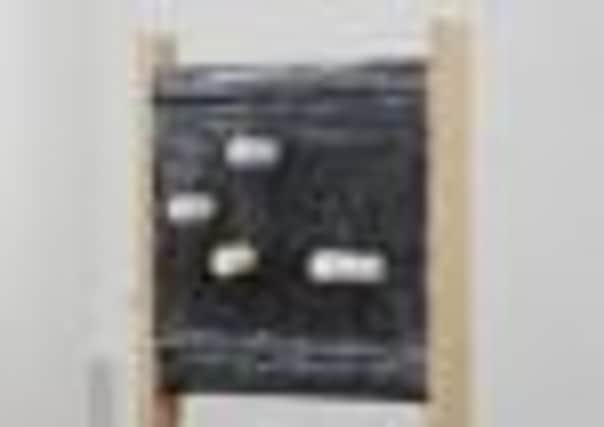Art: Laura Aldridge | Mick Peter | Niall Macdonald


Increasingly I recognise it’s hard work because of the footfall. Sometimes it’s like a town square rather than a gallery: a step away from the street, a first stop on a city visit just moments from the train station, a regular city centre hangout.
Spend more than half an hour in the place and you realise just how busy it is and you’ll have observed the gallery attendants performing the most extraordinary ritual dances trying to keep the place in one piece. Artworks and ideas need to be robust when faced with the onslaught of GoMA’s backpacking tourists, rampaging toddlers and opinionated, sophisticated local experts.
Advertisement
Hide AdThis week, I watched as heroic gallery attendants attempted to prevent small children clambering over the art without appearing discouraging. I couldn’t decide which side I was on. Mick Peter’s new sculpture, Albert And Jenny, a cartoonish blackboard punctured with giant sticks of chalk is just so deliciously playful, its chalkiness so chalky, its visual punch so immediate, that it’s virtually irresistible.
Peter is one of six Glasgow artists in Every Day, the second in GoMA’s series of small surveys of contemporary sculpture from artists based in the city. The new work, like his strong show at Edinburgh’s Collective Gallery during last year’s Edinburgh Art Festival, has its roots in the writing of the late B S Johnson.
Inspired by Johnson’s experimental novel Albert Angelo, about a frustrated schoolteacher, it is simple and comic, but somehow a little perverse. In the novel, Albert broods on his love life and ex-girlfriend and it’s difficult to resist a phallic interpretation of these large chalk columns squeezed into small holes. Peter, whose sources are as often in the literary or graphic design world, seems similarly frustrated with the formal languages of art and delightfully punches through sculptural conventions.
Indeed playing with conventions is commonplace, everyday, in the work of these six artists. Each has produced carefully crafted objects that echo yet undermine traditional forms.
Scott Myles’ picturesque ruined arch Law Of Large Numbers is made of powder-coated steel and its painted surface is marbled like the endpapers of an ancient book. Depth and surface, age and patina are all confused and confusing.
Carla Scott Fullerton’s teetering column is made of steel rebars, the stuff that forms the core of concrete structures. Look around the demolition sites of so much of central Glasgow at the moment and you’ll see this strong stuff strewn across the rubble like so much spaghetti.
Advertisement
Hide AdParticularly welcome is the chance to see some recent work by Hayley Tompkins just before she shows at the Scottish presentation at the Venice Biennale in June. I think of Tompkins as painter, but she often works in three dimensions and has long used everyday objects in her work, imbuing the ordinary stuff with a kind of incantatory magic.
A simple pine tabletop is scattered with carefully placed stuff: torn paper that has been silvered, so it might be the shards of a mirror or a puddle of glittering water. An old mobile phone and a twig are dipped in silver paint.
Advertisement
Hide AdNearby an umbrella lies open and two plain wooden chairs have been carefully painted in watercolour, one in a modernist confection of lozenges and squares, the surfaces decorated with tiny squares of mirrored glass, another in grids and stripes. All of this is commonplace and extraordinary at the same time.
Laura Aldridge has a clever, complex set piece, including large-scale photographs of women’s tummies and an image of a large orange mounted on wooden boxes. Small ceramic oranges and a piece of peel are scattered on the floor. Last year, Aldridge had a lovely show at Glasgow’s CCA entitled Underside, Backside, Inside, Even, which included a sequence of giant fabric pockets. Each work was a perfect simulation of a real piece of fabric but might have been a giant hammock, a space for a body to climb into and rest.
Here it’s all an elaborate pun on the navel. The human navel is the perfect sculptural conundrum about what is inside and what is outside, object and subject, the language between protrusion and indentation.
The fruit has similar qualities. Peel one and the limp, lifeless peel becomes a little metaphor for the complexities of form – what was once plump and spherical is suddenly flat. The navel orange is the extra sweet variety that contains a tiny little version of itself peeking out as though about to be born. But there’s a whole irony about that too. Navel oranges are actually a mutation and they are infertile. They are replicated through graft rather than seed. Aldridge’s deceptive simple work turns out to be a hall of mirrors.
I once saw a visitor, on the professional days at the Venice Biennale, coyly stroke a Chris Ofili painting when he thought no one was looking; on another occasion I caught a mildly inebriated collector viciously waggling a delicate bronze cast at an opening.
I longed to stroke Niall Macdonald’s pristine white plaster cast objects, fantastically modulated combinations of forms sitting on perfectly cast Ikea stools and side tables. A sea urchin shell sitting next to an ecstasy pill, a crude carved mask next to a guitar plectrum. They are like the ghosts of objects: barely there, but hallucinatory in their presence. Delicate, but terribly tough. I didn’t touch them, though. Please don’t. «
• Every Day, GoMA, Glasgow, until 1 September
Twitter: @moirajeffrey